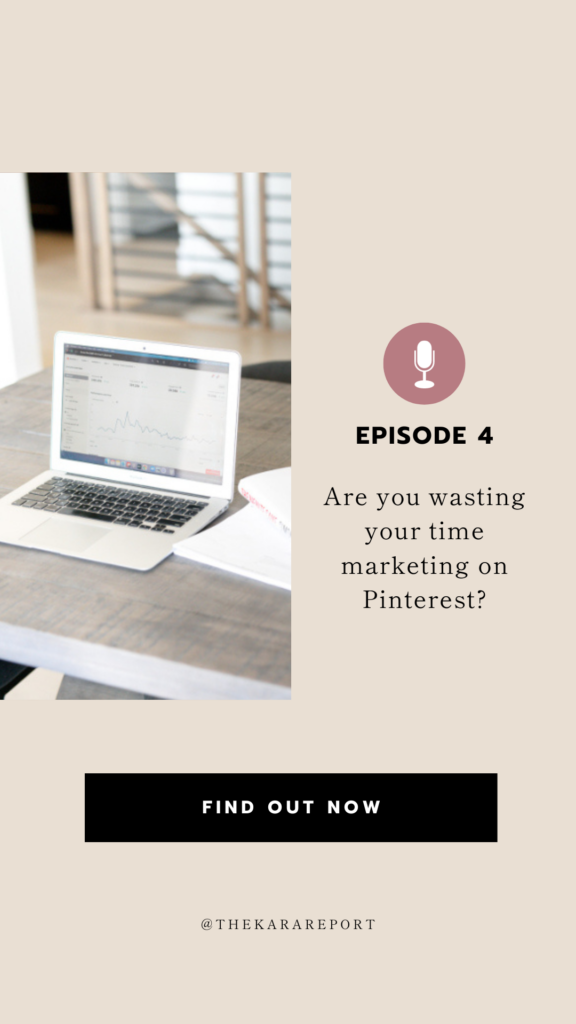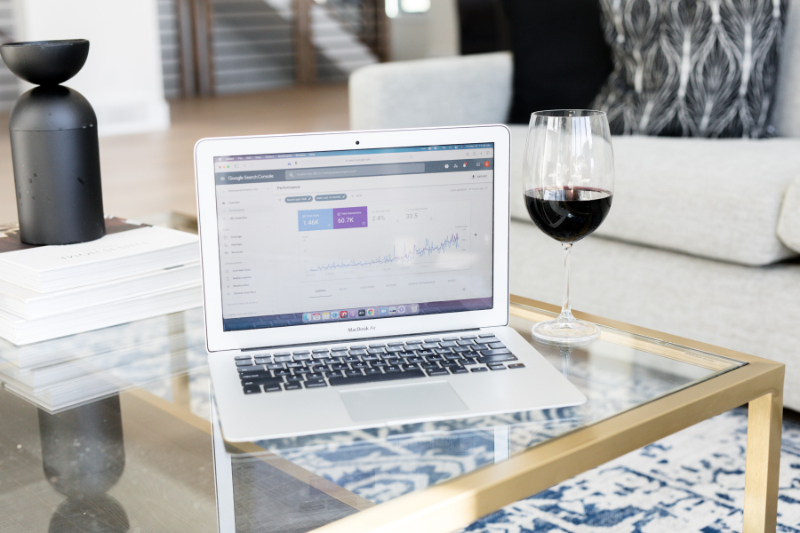We are ONE week into 2024, and I don’t know about you, but it feels like everybody is ready just to start a mutiny against Instagram. Everyone is sharing their goals, their marketing efforts, what they’re focusing on, what they’re calling in, all of that fun stuff, and hustling on Instagram is NOT it.
In this episode, we’re going to be talking about what you need to do before PINTEREST marketing (because I’m seeing more and more people express interest in it). While I love to see it (naturally – as a Pinterest manager), there are a few things that I think you have to have in place, specifically three things that you need, or you are just going to be wasting your time. We don’t have time to waste in 2024, do we? Let’s dive in!
Listen on Apple | Listen on Spotify
So that seems kind of looming, right? “You are just wasting your time if you don’t have these three things in place”, but I really mean it. I have had a few consultation calls lately where I have had to be really honest and say, I don’t think that Pinterest marketing for whatever reason is going to work for you at this time. I don’t think it’s where you should put your money. We’re going to talk about all of those things today (there are three things in particular!) that I believe you absolutely must have in place before starting with Pinterest marketing.
Table of Contents

1. Before Pinterest Marketing, You Need A Strong Website and/or Sales Funnel
Pinterest is really great for TRAFFIC. But, you need to have something in place to nurture and convert them once they find you. Pinterest really operates best at a top of funnel platform. I sometimes consider it a better top of funnel platform because people can save your pins and then they actually look at it later (unlike something like Instagram where let’s be honest, when’s the last time you went into your collections to browse or find something).
So keeping in mind that Pinterest works best for AWARENESS, that means that you need to have something in place that does those other two very important steps (warm up and sell!), if you plan on getting a monetary ROI from your Pinterest efforts.
Here’s an example of this in action!
As a service provider, you need to think about the customer journey from the moment they arrive on your site, which is often through a blog post. Once they land on your page, consider the next steps to lead them towards a purchase. This could involve providing high-quality content on your blog, encouraging them to sign up for your email list, or directing them to your active Instagram page.
For e-commerce businesses, there’s the potential to guide visitors directly from a blog post to a product page, especially if these pages are effective at converting new, or ‘cold,’ audiences. Remember, Pinterest users can be considered a cold audience, but they’re often more receptive since they’re actively searching for products like yours.
Essentially, the effectiveness of Pinterest for your business will largely depend on how well you’re currently converting traffic and managing your sales process. As a Pinterest manager especially, because I’ve been doing this for such a long time now, I feel like I need to educate people about the fact that Pinterest doesn’t make traffic convert. You need some sort of website funnel offer that converts. If you send Pinterest traffic to a bad website, they will bounce.
Do you have a bad website?
A ‘bad’ website can be unappealing in various ways. It might look outdated or visually unattractive. Or, it could be cluttered with too many ads or fail to clearly communicate its purpose, whether it’s offering a service or selling a product.
For example, in my early days as a wedding planner, I didn’t realize my website gave the impression of an informational resource rather than a service provider. A website audit revealed that visitors wouldn’t be able to tell the difference.
But don’t worry, improving your website doesn’t necessarily mean a complete overhaul. Start with small, ongoing adjustments. And make sure you have enough traffic to truly assess what’s going on! If you know you need an overhaul, learn more about our copywriting VIP days here (we will even input the copy into your template for you too!).

2. Before Pinterest Marketing, You Need Long-Form Content For Them to Consume
I currently advise creating four blog posts per month as a general guideline. However, this varies based on individual goals and needs. Some of my clients do well with just two posts monthly, while another manages eight. The key is to produce some form of long-form content, which could be a blog, a podcast episode, or a YouTube video. However, blogs are particularly effective for use with Pinterest.
Think about your own experience as a Pinterest user. What type of content do you usually look for? Often, it’s a blog post. Even if you don’t read it thoroughly, you might skim through it. Personally, I find it slightly disappointing when a Pinterest pin leads to a YouTube channel instead of written content.
Written content, especially when paired with Pinterest, is a powerful combination — I like to call it my ‘dynamic duo.’ It’s extremely effective, a real ‘chef’s kiss’ moment.
One thing I’ve learned over time is the importance of consistently adding new links to Pinterest. This means not repeatedly pinning the same content. For example, if you’re a photographer, don’t just pin an entire gallery linking to your homepage. Instead, it’s infinitely more effective to pin your best images from a specific wedding, directing users to a blog post about that wedding.
The Rule of 300
There’s a general guideline suggesting that each page on your website should contain at least 300 words. However, the ideal word count can vary greatly, especially for blog posts. Depending on the industry, a blog post might need anywhere from 900 to 2,000 words. This range is broad and depends on several factors, which I won’t delve into right now, but I’m open to discussing this in more detail if you send me a DM.
The reason I mention this ‘rule of 300’ is its relevance to Pinterest and user experience. For instance, you might wonder (I’ve been asked before!) if Pinterest can help build your email list without the need for blogging, by directly pinning to a landing page.
While this is possible, it’s important to consider how Pinterest users react to this approach. Typically, users expect content like a blog post when they click on a pin. If they are taken to a landing page instead, especially one that immediately asks for their email, they may feel misled and leave the site quickly.
Pinterest tracks user behavior on your site. A high bounce rate, where users leave your site quickly, can negatively impact your domain’s reputation on Pinterest. This can affect not just the pins leading to landing pages but your entire account’s performance on the platform. It’s not something I recommend!
Is Pinterest Worth It?
Interrupting the blog post for a second to say a resounding YES! Pinterest is not going anywhere, which is so exciting to see. The CEO just announced recently that Gen Z is the fastest growing segment, and they are up to 480 million monthly users. Yes – you’re ideal client IS searching on there. More and more people are going to be on the platform. It’s going to get more competitive. The best time to start is NOW.
3. Before Pinterest Marketing, You Need The Time and/or Money to Invest in Pinterest Marketing
This one is the least exciting and the most important before Pinterest marketing.
About a month ago, I was chatting with someone who was really hoping Pinterest could boost their upcoming launch in three to four months. They were pretty well-prepped, which is great because that’s a decent amount of time for a launch.
But here’s the deal: honestly, I didn’t think Pinterest was their best bet for pre-launch stuff. Why? It takes around six months to really get rolling on Pinterest. I usually say give it a year, not because you won’t see anything happening before then (you’ll get more views, saves, clicks and all that jazz way before a year’s up), but, it kind of takes a full year to get things really smooth and easy.
And I want to be super clear when I say this because if you’re hiring someone to manage your Pinterest, you’re probably hoping to see quick results, right? And as a fellow business owner, I get that. But the reality is, Pinterest can be slow, especially with new accounts. It takes a while before Pinterest marketing leads to them trusting your account.
Believe me, as someone who manages Pinterest accounts, I wish it was easier and faster from the get-go. We all do. But that’s how it is – 6-12 months is the reality. During that time, expect to tweak things and make some changes before everything’s running super smoothly.

Does 6-12 Months Feel Like a Long Time to Invest?
When I mention the time it takes to see results on Pinterest, people often find it daunting, yet they don’t realize how quickly time flies – many have been using platforms like Instagram for five years without a second thought. I don’t mean to discourage anyone by saying this. But before Pinterest marketing, you need to be realistic and prepared for the long haul, whether you’re managing your Pinterest account yourself or hiring a professional.
The key is to stay persistent, even if it seems like things aren’t progressing at first. Try not to fixate on your initial numbers in the first couple of months; it’s too easy to feel disheartened. We, as emotional beings, can react illogically to slow progress or underwhelming early results. If you find this discouragement too overwhelming, it might be worth considering a different platform. Pinterest is a long-term strategy, and it requires patience and resilience to see its true potential.
Bonus Tips For You Before Pinterest Marketing in 2024
Here are some bonus tips that will help make your start before Pinterest marketing as successful as possible.
Narrow In On Your Goals Before Pinterest Marketing In Your Business
This sounds obvious – but keep reading.
Let’s say those goals are sales-focused. You don’t always need a ton of clicks to get good business. A few well-targeted ones can often do the trick and give you a solid return on your investment. I mean, why worry about not hitting a million impressions? You don’t need that many.
Imagine you’re a wedding photographer looking to book, say, 15 couples a year. That’s your limit. Chasing after thousands of clicks every month doesn’t make sense. Instead, you should concentrate on niche keywords. Like if you’re based in Boston, focus on keywords related to ‘Boston wedding venues.’ That’s how you target your ideal clients.
But if your goal is to become a well-known name in your industry, you’ll want to focus on getting lots of views, even if they don’t always lead to clicks. This might mean creating eye-catching content like infographics and “no click” content. Just remember, aiming for a broad audience could slow down immediate sales, as you’re not targeting a specific group as much.
You might think you need a super specific niche to make money online. That’s not always true. It’s different for small business owners compared to content creators. Content creators often have a broader focus but monetize in different ways.
So, take some time to think about what you want from Pinterest. This can help keep you going, even when you hit month four and it feels like Pinterest isn’t paying attention yet.
And here’s a bit of good news: Pinterest can help boost your blog’s visibility on Google. In my wedding business, we rely a lot on blogging and Pinterest for leads. It’s pretty low maintenance now – just a couple of hours a month, and we’re booking up easily. We’ve been using Pinterest for seven years, and I can say it’s definitely worth it. So, don’t get discouraged. Think about your long-term vision for your business.

Get Your Domain Verified Before Pinterest Marketing
This one is quick – get your domain verified. Then you can get rich pins on Pinterest, which associates your profile with everything you create. It can be a great way to maintain and grow your visibility. Plus, Pinterest trust pins from verified domains more so they’re going to push you in the feed more.
Focus your Pinterest profile
Before Pinterest marketing is taken seriously, if you’ve got personal boards, like ones about food, consider archiving or deleting them. You want your Pinterest profile to be super focused on your niche.
For instance, if I’m setting up a profile, I might name it ‘The Kara Report: Pinterest Marketing and Blog Writing’ or something similar. Then, the boards should align with this theme. Aim for about 10 boards to start – there’s no magic number, but 10 is a good place to begin.
Make sure each board is distinct. Avoid having boards that overlap too much. For example, don’t create ‘Content Marketing’ and ‘Long Form Content’ as separate boards if they’re going to have similar pins. Instead, diversify with boards like ‘Pinterest Marketing,’ ‘Blogging Tips,’ ‘Podcasting Strategies,’ – whatever fits your content areas.
The goal is to set up your profile so it’s immediately clear who you are, what you discuss, and who you’re targeting. For instance, you could have a board titled ‘Tips for Female Entrepreneurs’ or ‘Women-Owned Small Businesses’ if that’s your audience. If you’re in the wedding industry, try having a separate board for each venue you work with or aspire to work with. This way, each board is specific and targeted, but all are relevant to your niche and what you want to show up in searches for.
Just to recap – you are wasting your time on Pinterest if you don’t have these three things set up first!
Do these three things before Pinterest marketing! First, you need a sales process that works. Two, a plan to create long form content regularly (and ideally you have a bank of long form content already ready to go). And three, time or money to invest in a new platform. Again, you spent a ton of time building your Instagram. Try and approach Pinterest with the same willingness to stick through it when it’s hard. We will be cheering you on as you do!
Links Mentioned:
- Hire us to manage your Pinterest marketing
- Learn more about working with our marketing agency here
- Follow me on Instagram